 Bluetooth is new
technology we have been hearing about for a long time now, but what is it
really?
Bluetooth is new
technology we have been hearing about for a long time now, but what is it
really?
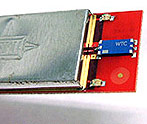 Is it a big blue tooth from your dentist? Well....No. What
Bluetooth really represents is a "wireless personal connectivity standard" and
what Bluetooth does is enable short-range wireless connections between computers
or mobile devices which support it.
Is it a big blue tooth from your dentist? Well....No. What
Bluetooth really represents is a "wireless personal connectivity standard" and
what Bluetooth does is enable short-range wireless connections between computers
or mobile devices which support it.
"Bluetooth" is
actually the name of the standard, which is controlled by
Bluetooth SIG , a
consortium of companies including; 3Com, Ericsson, Microsoft, Nokia, Agere, IBM,
Intel, Motorola and Toshiba. Bluetooth is not the little blue antenna pictured
on the red PCB of the MSI dongle to the left.
Investigating
further we find out the actual chip is a BlueCore2, made by Cambridge Silicon
Radio (
www.csr.com). It is
a 0.18 micron BGA chip with integrated baseband DSP, radio, and on chip RISC microcontroller.
Bluetooth data transfer rates hover around
723Kbps (Kilobits ) over a max +18dBm 2.4GHz wireless
signal. The 2.4GHz ISM band is the same one used by many cellphones, and 802.11b
wireless LAN, but the two are not interoperable. The MSI adaptors have a listed
range of about 200 meters in an open, unobstructed area. Once you start putting
things like walls, people, and computers in the way of the transceivers that
distance can be halved quite easily.
"Unlike many other wireless standards, the Bluetooth wireless
specification includes both link layer and application layer definitions for
product developers which supports data, voice and content-centric applications.
Radios that comply with the Bluetooth wireless specification operate in the
unlicensed, 2.4 GHz radio spectrum ensuring communication compatibility
worldwide. These radios use a spread spectrum, frequency hopping, full-duplex
signal at up to 1600 hops/sec. The signal hops among 79 frequencies at 1 MHz
intervals to give a high degree of interference immunity. Up to seven
simultaneous connections can established and maintained."
From the long list
of added goodies on the back of the KT3 Ultra2's box (Liveupdate 2, FuzzyLogic
4, S-Bracket, D-Bracket 2, and now PC2PC Bluetooth) we can see that MSI work
hard to try and differentiate their motherboards from the rest of the
competition. As of this review, they are one of only a handful of mainboard
manufacturers to offer a Bluetooth enabled motherboard. In fact the only other
company to come to mind right now is Epox.
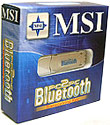 |
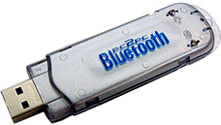 |
| Services supported: Dial-up
Networking, Fax, File Transfer, Information Exchange, Information
Synchronization, Network access, and Bluetooth Serial
Port.
|
Bluetooth is very
much like the now ancient laplink where we had a "client" and "server." With
a wireless connection instead of a wired one, the client sends out a
request to the server asking for a connection. The server, which can be a
remote computer, mobile device or even a printer must accept
that request before a connection can be
established. Most Bluetooth devices can operate as both client and
server, and the software needed to setup that connection runs in the
background.
The dongle and
transceiving module MSI offer are Bluetooth connection spec v1.1 compatible and support
piconet point-to-point, point-to-multipoint, and shortly, scatternet. The dongle
has a small internal antenna, and the transceiving module uses an external
Dipole antenna on short 24" extension SMA cable.
Once again, with
its maximum transfer speed sitting at 732 Kbps, Bluetooth is not really
intended for LAN gaming or internet sharing home networks. It's
good for sending things to a Bluetooth compatible printer or transferring
small files between computers.
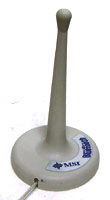 |
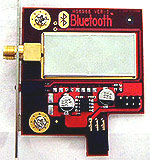 |
| Antenna |
Bluetooth Transceiver |
To test out MSI's
PC2PC Bluetooth setup, I connected the test KT3 Ultra 2 system wirelessly
to my main rig (not hard to do). A 1 MB dummy file was
transferred between the two computers and this took
approximately 15 seconds to complete, the dongle flashing with
blue and red LED's the whole time.
Bluetooth
is not the fastest wireless option out there, but it's also important to
realize that it isn't trying to bel. Other, more expensive wireless LAN
technologies like 802.11b, 802.11a, or even 802.11g are being implemented
to card upto 54MB/s of data through the airwaves.
Bluetooth is a very
simple, and fairly robust wireless system which is easily implementable, and
ideally suited for small data transfers between computers, mobile devices or
peripherals like printers. Much like USB2.0, there aren't that many
peripherals out right now that support the standard, but cellphones are
quickly adopting it so it is something to look forward to, or in this case start
using.
